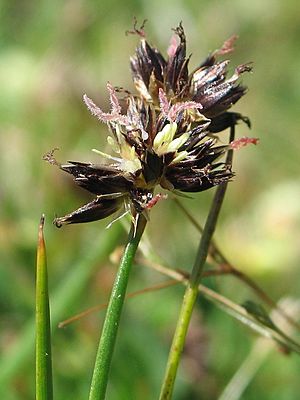Brown-headed rush facts for kids
The brown-headed rush (Juncus phaeocephalus) is a type of grass-like plant. It grows mostly along the coast of California. You can also find it further north in Oregon and Washington. This plant likes to grow in wet places. It thrives in moist spots where water seeps out of the ground. It also likes shallow, wet soil.
Quick facts for kids Brown-headed rush |
|
|---|---|
 |
|
| Juncus phaeocephalus var. phaeocephalus | |
| Scientific classification | |
| Genus: |
Juncus
|
| Species: |
phaeocephalus
|
Contents
Where Does the Brown-Headed Rush Grow?
The brown-headed rush is a plant that naturally lives along the coast of California. It can be found in wet meadows and near swamps. Its range stretches from Los Angeles County up to Mendocino County. It also grows further north in Oregon and Washington.
Habitats Where This Plant Thrives
This plant enjoys growing in coastal areas. You might see it in sand dunes, marshes, and wet, muddy areas called sloughs. Some brown-headed rush plants also grow further inland. They like wet, grassy meadows, bogs, and areas along lakes and streams. For example, they can be found in the Peninsular Ranges and Transverse Ranges of Southern California.
This plant has special underground stems called rhizomes. These rhizomes creep and spread across moist soil. The brown-headed rush is a perennial plant. This means it lives for more than two years. It can grow in places up to about 7,200 feet (2,200 meters) high.
What Does the Brown-Headed Rush Look Like?
The brown-headed rush is a grass-like plant. It has strong, creeping underground stems called rhizomes. These rhizomes help the plant spread. Its stems are flat and have two edges. They can grow up to about 1.5 feet (0.46 meters) tall.
The leaves of the brown-headed rush are shorter than its flowering stems. Its flowers are brownish. They grow in round clusters at the very top of the flowering stems. Sometimes, people might mistake the brown-headed rush for sedges or irises. This is because their stems and leaves look similar.
This plant makes many seeds. These seeds are shaped like small eggs. They are very tiny, only about 0.02 inches (0.6 millimeters) in size.
Different Types of Brown-Headed Rush
The brown-headed rush is a plant that can look a bit different depending on where it grows. Scientists have found a few different types, or varieties, of this plant. These varieties are mainly identified by how their flower clusters branch out.
Here are some of the named varieties:
- J. phaeocephalus var. phaeocephalus: These plants have a few flower clusters, but each cluster has many flowers.
- J. phaeocephalus var. paniculatus: These plants have many flower clusters, but each cluster has only a few flowers.
- J. phaeocephalus var. glomeratus: These plants have many flower clusters, and each cluster has many flowers.
Is the Brown-Headed Rush Safe?
Tests have shown that the brown-headed rush contains a small amount of a chemical called hydrocyanic acid. This chemical can be harmful if eaten. Because of its nature, the actual amount of this chemical in the plant might be higher when it's fresh.
There was a situation in California where farm animals became ill after eating this plant. In 1958, two young cows on a farm near Petaluma in Sonoma County became very sick. They had eaten brown-headed rush plants. The brown-headed rush often grows alongside other plants. These include Verbena species, Mimulus guttatus, Eleocharis macrostachya, and Agrostis densiflora.

